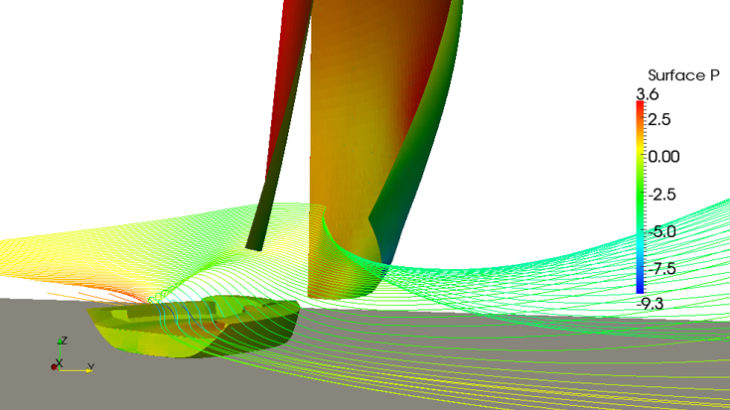Modelling downward sailing conditions

North Sails are one of the largest sail making companies, with a particular emphasis upon and commitment to technical development. This ranges from the materials used to the manufacturing process and the design of the sail. North Sails operate world-wide, producing sails for boats ranging from 4m dinghies to 200m super yachts, from classic cruising yachts to the Americas Cup racing catamarans.
Designing the shape of sails is a challenging task and traditionally completed using experience and trial and error. The fundamental design issue is one of matching the structural properties of the sail to the fluid dynamic loading from the air. Within this there are many considerations: such as twisted air flows due to the boat operating in the atmospheric boundary layer; large zones of separated flow due to the use of thin aerofoils (i.e. the sails); and the changes to the shape and deflection of the material as the wind speed changes. The overall sail shape is a complex 3D aerofoil controlled by the sailor via numerous controls, resulting in a complex and highly non-linear fluid structural interaction problem.
North Sails have a suite of design tools, incorporating structural analysis software and potential flow Computational Fluid Dynamics (CFD) solvers. For a number of cases, such as sailing upwind where there is little separated flow, potential flow solvers are accurate, but for the majority of cases higher order solvers, such as RANS (Reynolds Averaged Navier Stokes) are required. These types of simulations are however very expensive in computational terms, and require expert use. North Sails have had access to, and used, RANS solvers in the past but due to limitations on resources RANS solvers were only used for a few high profile projects.
Performance prediction for Americas Cup catamaran
Solution
North Sails approached the Wolfson Unit initially in 2010 with the challenge of providing a turnkey CFD solver that could accurately model downwind sailing conditions (i.e. a highly twisted air stream with large zones of separated flow) to predict the pressure on the sail for structural analysis. This tool would need to be available on demand to the designer and return results in a few hours. This required 3 key features for it to succeed:
- access to power of supercomputer
- reduced / minimal man time over head
- lack of lengthy tie in periods to software
The solution devised resolved these requirements by using:
- Iridis 3 & 4 – international level computing resource
- OpenFOAM – open source RANS solver
- Range of scripting languages to link OpenFOAM, Iridis HPC resources and the North Sails designers via internet protocols.
The solution is a desktop based application where the designer specifies the geometry and wind conditions and what outputs are desired. This information is sent via SFTP protocols to the Wolfson Unit server where automated scripts control the process of putting and collection individual simulations onto the Iridis HPC facility. The parameters of the simulation are set according to the designers requirements and are based upon templates set according to the expertise of Wolfson Unit engineers.
The simulations run on behalf of the sail designer are full high fidelity RANS simulations, modelling all salient flow features, with each run having in the region of 20 million data points, running on 24 – 32 processors and using 100-200 CPU hours each. This process is fully automated, with the only human interaction being by the sail designer, as they specify a case and analyse the results. This removal of oversight by an expert allows a cost effective solution.
The unique aspect to this system is the use of the Iridis HPC facility which allows the vast numbers of such simulations required for design development to be completed in the requisite time frame of a few hours. Over the last few years, as the system as developed and the computing power available via the upgrade of Iridis 3 to Iridis 4, the reliance of North Sails upon the system has increased, as Michael Richelsen (Director of Design Systems, North Sails) has commented, “We are all impressed with the setup and likewise we have come to trust the results. So all in all we are happy users – only wanting to use your setup even more!”
Aerodynamic flow past a multi-masted yacht
Impact
North Sails designers now use the system on a daily basis, operating from different locations around the world, running hundreds of RANS simulations per month. The system has been successful enough that RANS simulations, thought of as a research and development tool a few years ago is now a standard design tool.
In addition, the original target of providing accurate pressure mapping for structural analysis has been surpassed with the new goal of using RANS simulations as the driver for complete performance prediction models, which requires hundreds of simulations per design. This is readily achievable with the Iridis computing power. Moreover, the increased levels of accuracy available have allowed the designers to study in depth the influence of individual parameters upon performance and loading.
The overall impact is that North Sails can now design sails to be longer lasting with higher performance thought greater understanding of the aerodynamic forces being applied.
Pressure mapping on down wind sails for a range of sail sets and wind angle settings

